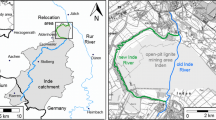Abstract
The morphological evolution, hydrodynamics and sediment dynamics of the lower Ebro are studied from historical and current data in order to determine the main changes that have governed the evolution of the Ebro channel near the river mouth during the last few centuries. The evolution of the mouth of this river during the last 2000-years, from an estuary to a delta, is interpreted as a process that has been accelerated by human land management. However, an inverse trend has been observed during recent decades: (1) the river mouth has been affected by erosion due to a drastic decrease in the river sediment discharge, and (2) the lower Ebro tends to evolve towards a quasi-permanent salt-wedge estuary as a consequence of the decrease in the river water discharge. Freshwater and sediment discharge decreases are mainly related to intense river water management during this century. The salt wedge favours erosion in the river banks, widening the river channel and causing an aggradational trend in the lower Ebro. Accretion-erosion rates and the sediment budget in the river mouth are estimated for different conditions.
Similar content being viewed by others
Author information
Authors and Affiliations
Additional information
Received: 13 November 1995 · Accepted: 17 June 1996
Rights and permissions
About this article
Cite this article
Guillén, J., Palanques, A. A historical perspective of the morphological evolution in the lower Ebro river. Environmental Geology 30, 174–180 (1997). https://doi.org/10.1007/s002540050144
Issue Date:
DOI: https://doi.org/10.1007/s002540050144




